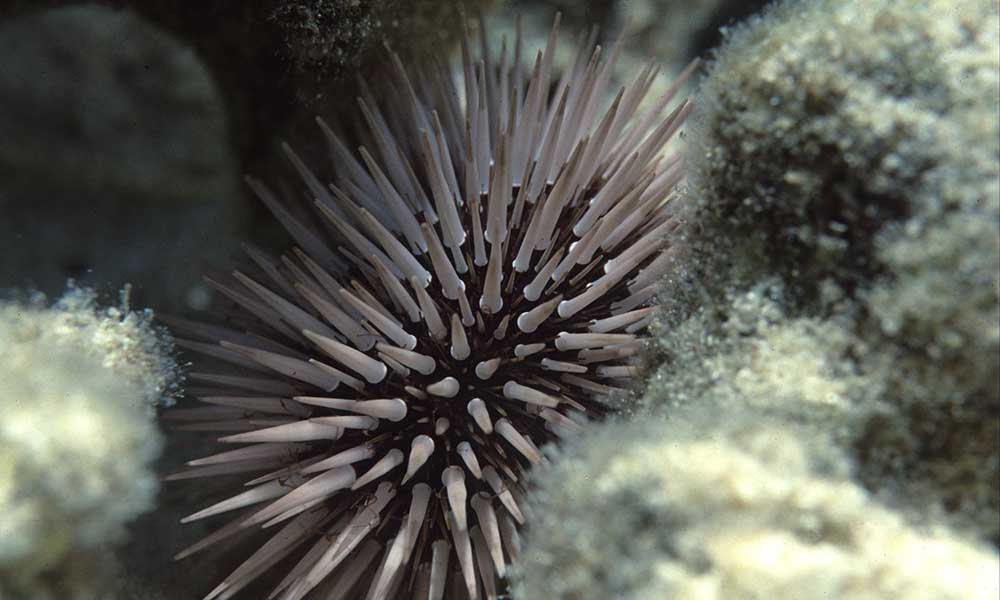Many people including surfers accidentally step on sea urchins in the ocean because they look similar to rocks and shells, causing them to blend in with their surroundings.
But what happens if you step on one, do their spikes contain poison and should you pee on a sea urchin sting?
Let’s find out.
Do You Pee On A Sea Urchin Sting?
No, studies show that urine does not treat injuries caused by stepping on sea urchins.
In fact, it can even make the pain more severe and uncomfortable.
This will also not kill any of the bacteria that is present in the skin and can lead to an infection.
Using soap and water or warm water and vinegar is the best solution to ensure the site is thoroughly cleaned.
What Is A Sea Urchin
A sea urchin is a sea animal that frequently has a spiky exterior.
Some are vibrant purple, others are red, and maybe the most well-known sea urchin is white.
As primitive animals, sea urchins have a strong defense mechanism with their spikes, which are extremely painful for people who come into contact with them.
Sea urchins are extremely common in the Pacific and Indian oceans and can live in both warm and colder waters.
Sea urchins are not aggressive, but they sure do pack a punch if you come into contact with their spiky exterior, which is not uncommon given that they reside in somewhat shallow water on coral reefs and rocks where humans can easily step on them or try to pick them up not knowing the consequences of doing so.
What Happens If You Step On A Sea Urchin?
If you accidentally step on a sea urchin, you’ll immediately experience pain, especially if you applied force to the urchin. Swelling and redness can follow, along with an infection.
If the sea urchin punctures your skin deep enough, it can lead to breathing issues and muscle aches.
Symptoms of Sea Urchin Stings
Severe sea urchin stings can be dangerous and you should seek medical attention if you experience one or more of the below symptoms which are typically associated with deep puncture wound from venomous spikes.
- Swelling and redness at the puncture points
- Muscle aches
- Difficulty breathing
- Shock
- Fatigue
- Paralysis
- Dizziness
- Change in heart rate
- Nausea or vomiting
How To Treat A Sea Urchin Sting
For less severe stings you may want to treat them yourself.
It’s important to immediately remove as much of the sea urchin spikes as possible from your skin.
Be careful when handling the pieces because they can break into even smaller pieces as you attempt to remove them.
Use a razor to remove all the spikes and then wash the injury with soap and water to remove all the bacteria.
Allow it to remain clean as it heals to avoid infections.
Soaking the area in a combination of hot water and vinegar will also make it easier for the particles to come out of the skin because the vinegar will make the skin around the spikes shrink allowing you to pull out the spikes more easily.
It will also reduce inflammation and offer pain relief. You may need to do this multiple times to get the spikes out.
There may be a few smaller pieces lodged into the skin, but the body can naturally push them out over time if they are not lodged too deeply in the first place.
If the puncture wounds are deep you should see a doctor as the left over spikes may move deeper into the skin which can cause tissue, bone and nerve damage.
If you notice the symptoms are only becoming more severe after a few days, immediately visit a doctor for proper treatment.
Are Sea Urchins Poisonous?
Yes, many types of sea urchins are poisonous and some can even bite.
When sea urchins bite, they release venom but don’t leave any spines behind.
Sea urchins can trigger allergic reactions in some individuals, which can be mild or even deadly.
Those who have had allergic reactions in the past are prone to reacting more severely to sea urchin bites.
The sting of a sea urchin can cause damage to the tissue, skin, and bone, depending on its severity.
Sea urchins have spines that are filled with calcium and are often painful to remove once they have contact with the skin.
These spines are present to warn predators of impending danger.
The most dangerous sea urchin is the flower sea urchin which live in the Indo-West Pacific.
The toxin that this type of sea urchin releases from its spine leads to respiratory issues, paralysis, and extreme pain that can be debilitating and life-threatening.
How To Avoid Stepping On Sea Urchins
Avoiding sea urchins is the first step to preventing sea urchin stings.
You can try to spot sea urchins before you get into the water and simply find another entry point to swim, snorkel or surf if you do see them.
Avoid walking on the reef.
This is where many sea urchins live, so if you don’t step on the reef you will avoid stepping on them.
Also, stepping on the reef damages and kills the reef so you want to avoid stepping on it regardless.
Surfer should be aware of the reef when they are surfing. If you fall on top of a reef do your best to avoid contact with the reef by not immediately putting your feet down.
213456Instead, tread water and swim to your surfboard.
Worst case scenario, avoid stepping on any dark areas in the reef as this may be where the sea urchins are.







